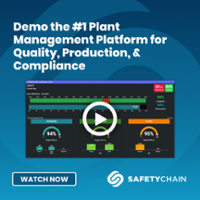Cook to Chill: What It Is & How to Track the Process in Your Plant
Cook to chill, sometimes also referred to as the “cook-chill method” or “cook to cool,” is a food preparation process by which cooked food is rapidly cooled to ensure food is safe and free of pathogenic or spore-forming bacteria and other microorganisms. It requires food to be cooked, then cooled, to specific temperature ranges within tight windows of time and must, therefore, be closely monitored in food manufacturing and processing facilities. We created a quick video to show you how SafetyChain software helps food and beverage companies satisfy this critical requirement for USDA programs and PCQI operations.
What Is the Cook to Chill Process?
While cook to chill has very specific requirements, its benefits are well worth the effort: the method offers a cost-effective means for providing ready-to-eat/use (even though most are reheated they are considered in the industry as RTE or RTU - Ready to eat or use) foods to the masses. The concept is based on the fact that foodborne organisms, which can lead to foodborne illness and spoilage, proliferate between the temperatures of 80 - 130°F (26.6 - 54.4°C).
The Challenges of Cook to Chill
To promote optimal food safety and compliance, temperatures need to be achieved and then recorded throughout the cooking and chilling processes. Time must also be tracked: in most cook to chill systems, the temperature drop must take place within 90 minutes from the end of the cook cycle. Since bacteria grow most aggressively between the temperatures of 130° and 80°F (54.4° - 26.6°C), the objective is to get through this “danger zone” as quickly as possible. To comply with food safety regulations, manufacturers can’t simply place hot food on a counter or in a large walk-in refrigerator to cool, they must use industrial cooling or freezing systems to facilitate rapid cooling. Many times this is a spiral freezer, water chilling bath, or a blast freezer.
“Cook to chill data hasn’t been easy to capture, report or audit, but many of our customers needed a simple, audit-ready approach that was flexible enough to handle poultry, rice, starches, and anything we could throw at it,” Says Geoff Nelson, Sr. Director of Engineering at SafetyChain Software. “It’s great to work this closely with customers to develop an innovative approach to this common challenge.”
As in any food processing step, it’s possible for issues to arise during the cook-to-chill method. To that end, monitoring time and temperature becomes critical. With SafetyChain, this sophisticated verification process can be tracked at the lot/batch level. The software is designed to support regulatory requirements and allows managers to quickly spot non-compliances, conduct reviews, and sign off on USDA pre-shipment and PCQI reviews. As you’ll see in the video, for instance, when a specific lot doesn’t achieve the proper temperature the first time, it triggers a non-compliance in the system which can then be investigated.
With this streamlined system, food safety managers no longer have to run around on the floor, chase down paperwork, review handwritten initials, and check dates and times. Sound familiar? Instead, all of the information regarding their plant’s cook to chill program comes directly to management teams in a ready-to-review format in real time from any mobile device or their computer.



